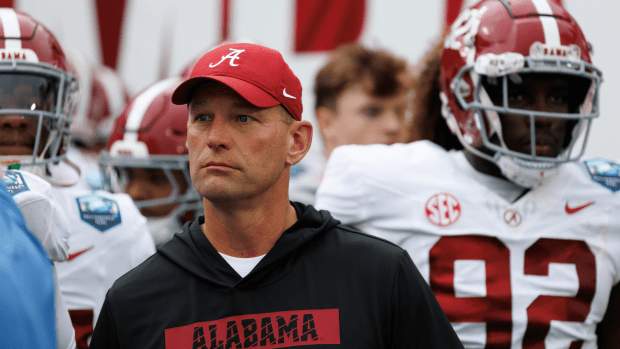Alabama football summer update: Could tight end become a key weapon in Crimson Tide’s 2025 offensive attack?
As Alabama football continues its preparation for the 2025 season under the leadership of head coach Kalen DeBoer, the attention has turned to an often overlooked but potentially game-changing position on offense: tight end. In the grand history of Alabama football, tight ends have frequently taken a back seat to the program’s power running game and deep pool of elite wide receivers. However, as the Crimson Tide adapt to a new offensive identity in the post-Nick Saban era, there’s growing speculation that the tight end position could emerge as a significant weapon in the team’s arsenal. With changes in coaching philosophy, roster development, and a more expansive offensive scheme, Alabama fans might be witnessing a new chapter where tight ends play a central role in the team’s success.
Historically, Alabama’s offense has been built on a strong ground game and physical dominance up front. From Derrick Henry to Najee Harris, the Tide’s bruising style has been its identity. But in recent years, Alabama’s evolution into a more pass-happy attack has seen the emergence of top-tier quarterbacks and explosive receivers like Tua Tagovailoa, Mac Jones, Bryce Young, DeVonta Smith, Jaylen Waddle, and Jameson Williams. Through all of that, tight ends have largely functioned as blockers with the occasional short-yardage reception. That could be about to change. Under DeBoer’s vision, and with new offensive coordinator Nick Sheridan guiding the playbook, Alabama appears poised to bring tight ends into the spotlight in ways that fans haven’t seen in years.
Sheridan, who arrives with a history of utilizing the tight end position effectively, especially during his time at Indiana and Washington, brings a system that thrives on tight end versatility. At Washington, his offense made productive use of tight ends, integrating them into play-action, short-yardage, and red zone packages with success. For Alabama, this could mean more frequent two-tight end sets, motion across the formation, and tight ends flexed out into the slot or even split wide. If spring practices and early summer workouts are any indication, the tight end position is not only being emphasized—it’s being prioritized as a mismatch tool to stress opposing defenses.
One of the biggest names to watch is redshirt sophomore Danny Lewis Jr., who has been drawing attention throughout the offseason. A 6-foot-5, 255-pound physical specimen, Lewis has the build to be a traditional in-line blocker but also possesses soft hands and route-running ability that could allow him to stretch the field. His performance in the spring game gave fans a glimpse of what he could become, as he showed good timing with the quarterbacks and reliable catching ability over the middle. If Lewis can continue to develop his blocking skills while maintaining his receiving threat, he could become a go-to option in short-yardage and third-down situations.
Another intriguing option is true freshman Caleb Odom, a dynamic playmaker out of Georgia who turned heads during high school for his ability to run crisp routes and make contested catches downfield. At 6-foot-6 and with a wingspan that rivals some wideouts, Odom offers a rare blend of athleticism and length that is ideal for creating mismatches against linebackers and safeties. His transition to college football will require adjustment, particularly in terms of physicality and blocking assignments, but his ceiling is sky-high. With proper development, Odom could quickly become the kind of tight end that stretches defenses vertically and forces opposing coordinators to adjust their schemes.
Returning upperclassman Robbie Ouzts provides the Tide with a more traditional, physical presence. Known more for his blocking than receiving, Ouzts is a blue-collar player who does the dirty work in the trenches. However, that doesn’t mean he can’t contribute in the passing game. Ouzts has shown flashes of dependable hands and could benefit from increased targets if Alabama begins to emphasize the position more. His experience and toughness make him a valuable asset, especially in two-tight end sets where one player stays in to block while the other runs a route.
The potential rise of the tight end group isn’t just about individual talent—it’s also about how their usage could reshape Alabama’s offensive balance. With a quarterback battle still ongoing between Jalen Milroe, Ty Simpson, and Julian Sayin, having dependable safety valves at tight end could make all the difference. Quarterbacks at every level of the game love having tight ends who can find soft spots in zone coverage or shield defenders with their bodies on quick throws. For an Alabama offense that may feature more intermediate passing and motion-based concepts under Sheridan, tight ends could play a vital role in sustaining drives and controlling tempo.
Additionally, tight ends can influence the run game just as much as the passing game. In Sheridan’s scheme, tight ends are asked to block at the point of attack, pull across formations, and even serve as lead blockers in outside zone or power runs. Their ability to sell blocks and then leak into the flat or seam also adds layers of deception to the play-action game. If Alabama’s offensive line continues to develop chemistry and physicality, the presence of capable tight ends will only enhance the effectiveness of the run-pass option game, something the Crimson Tide have relied on heavily in recent years.
Another element to consider is how the tight end position could impact red zone efficiency. While Alabama has traditionally been solid inside the 20, there have been recent stretches where the offense has stalled. Having tight ends who can operate in tight spaces, shield defenders, and out-leap smaller defensive backs could be the solution to some of those problems. Throwing fades or seam routes to Odom or Lewis offers a high-percentage option when space is limited. That versatility becomes even more critical in the postseason when games often come down to execution in the red zone and on third down.
From a recruiting standpoint, the emergence of the tight end position also sends a message to future prospects. If Alabama can show that it’s willing to feature tight ends in its scheme, it opens the door to attracting more elite talent at the position. Programs like Georgia, Notre Dame, and Iowa have built reputations as tight end factories by consistently utilizing and developing the position. If Alabama can showcase similar usage in 2025, it could reshape how top tight end recruits view the program. The presence of early contributors like Odom could be just the beginning of a pipeline that brings in more dynamic playmakers.
Of course, much of this is still projection. Training camp, live game reps, and health will all determine how significant the tight end position ultimately becomes. But there’s little doubt that the ingredients are there for a breakout year. A new system, talented young players, and a desire to expand the playbook create a recipe for tight end success. If Alabama embraces this shift and commits to it fully, the position could become a defining feature of the offense—something that sets the Crimson Tide apart in a crowded SEC race.
Fans shouldn’t expect a complete overhaul overnight, but they should be optimistic about the early signs. Whether it’s Lewis serving as the reliable chain-mover, Odom providing explosive plays, or Ouzts anchoring the ground game, Alabama’s tight ends are poised to step into a larger spotlight. The coaching staff appears committed to leveraging their skill sets, and in today’s college football landscape, that adaptability is often the difference between good and great.
As Alabama inches closer to the start of the 2025 season, all eyes will be on quarterback play, offensive line cohesion, and receiver development. But those paying close attention know that tight ends may hold the key to unlocking a more versatile, balanced, and dangerous offense. It may not be the flashiest position, but in the right hands—and under the right system—it could be one of the most impactful. The quiet evolution is underway, and by the time fall arrives, Alabama’s tight ends may no longer be the supporting cast—they might just be the stars.


